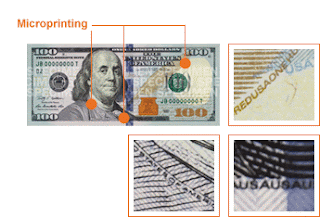The new $100 bill was released by the U.S. Treasury Department on April 21, 2010. This new bill thwarts high tech counterfeiters with its enhanced security features that make it much more difficult for counterfeiters to produce fraudulent currency that mimics the appearance of a true new $100 bill. The new $100 bill is the most recent currency update and follows similar changes to the $5, $10, $20 and $50 bills.
Some of the security features on the new currency are the same as the old $100 bill because they are still good ways to deter high tech currency counterfeiters. These older security attributes include microprinting, and the second portrait of Benjamin Franklin that appears only when the bill is held up to light.
In the case of microprinting on the new $100 bill, it has been developed further to thwart high tech counterfeiters printing techniques. Specifically, the new $100 bill does this with a security thread along the side of the portrait that reads USD 100. Color shifting ink has also been added to the new $100 bill in addition to more color within the note. The new $100 bill contrasts heavily with the old $100 dollar bill.
Image attributions: US-PDGov
Money is often re-designed every several years to stay ahead of creative counterfeiters who make use of technology to create phony $100 bills. The last redesign of the $100 bill was in 1996 when Benjamin Franklin's watermark portrait made its debut. The new $100 bill will be produced and distributed by the U.S. Bureau of engraving and printing and is not scheduled to be in circulation until 2011.
The question of who the high tech counterfeiters are remains. In June 2009, the Congressional Research Service reported the Republic of North Korea to be counterfeiting large amounts of U.S. $100 bills. The report estimates $45 million in U.S. $100 bills to have been circulated by this particular suspected counterfeiter alone. Although this is a large amount of money, it is much less than 33%-50% of counterfeit U.S. currency believed to be in circulation at the end of the U.S. Civil by the Federal Reserve Bank of San Francisco No doubt, the new $100 bill should help thwart further attempts at counterfeiting $100 bills.
In 2006, the U.S. Treasury reported an estimated 1 in 10,000 us currency notes were counterfeit. By producing a new $100 bill, the Treasury is helping to ensure U.S. Currency remains a trusted currency throughout the world in which it has been widely used. By better protecting against high tech currency counterfeiters, the U.S. Treasury is also better able to account for and manage money supply more effectively.
Sources:
1. http://www.treas.gov/offices/domestic-finance/acd/if-you-suspect.shtml
2. http://www.uspapermoney.info/history/1996.html
3. http://fas.org/sgp/crs/row/RL33324.pdf
4. http://www.frbsf.org/federalreserve/money/funfacts.html#A2
5. http://www.ustreas.gov/press/releases/hp154.htm








 :.
:.
0 comments:
Post a Comment